Lead-acid battery is an important part of UPS system. Its quality is directly related to the reliability of the whole UPS system. No matter how advanced the ups design is and how complete the functions are. Once the lead-acid battery fails, the best UPS cannot supply uninterrupted power. Do not choose low-quality lead-acid batteries for the sake of cheapness, which will affect the reliability of the whole UPS system and cause greater losses.
The lead-acid battery is the part with the shortest mean time between failures in the whole UPS system. If it can be used and maintained correctly, its service life can be prolonged, on the contrary, its service life will be greatly shortened.

Important factors affecting the service life of lead-acid battery
Ambient temperature
If the ambient temperature is too high, the lead-acid battery will be overcharged and gas will appear. If the ambient temperature is too low, the lead-acid battery will be under charged, which will affect the service life of the lead-acid battery.
Discharge depth
The deeper the discharge depth of the lead-acid battery, the less the number of cycles. Therefore, deep discharge shall be prevented during use.
Self discharge
During storage, transportation and installation, the lead-acid battery will lose part of its capacity due to self discharge. Therefore, after installation and before putting into use, the remaining capacity of the lead-acid battery should be judged according to the open circuit voltage of the lead-acid battery. Then, different methods are used to recharge the lead-acid battery. The standby storage lead-acid battery shall be recharged every 3 months. The quality of the lead-acid battery can be judged by measuring the open circuit voltage of the lead-acid battery.
Charging voltage
Because UPS lead-acid battery belongs to standby working mode. Under normal conditions, it is in the charging state, and it will discharge only when the power is cut off. In order to prolong the service life of the lead-acid battery, the charger of UPS is generally controlled by constant voltage and current limiting. After the lead-acid battery is full, it will turn to floating charge. If the charging voltage is too high, the lead-acid battery will be overcharged, otherwise the lead-acid battery will be undercharged.
Lead-acid battery overcharge
The lead-acid battery will not appear any gas during normal use, but if the user uses it improperly, resulting in overcharging of the lead-acid battery, gas will appear. At this time, the internal pressure of the lead-acid battery will increase, and the pressure valve on the lead-acid battery will be pushed open, which will seriously burst the lead-acid battery. During the operation of UPS, pay attention to monitor the terminal voltage value of lead-acid battery pack, floating charge current value, voltage value of each lead-acid battery, ground resistance and insulation state of lead-acid battery pack and DC bus.
Storage location
The lead-acid battery shall be installed in a clean, cool, ventilated and dry place as far as possible, and shall be protected from the influence of sunlight, heater or other radiant heat sources. The lead-acid battery shall be placed upright without inclination. The terminal connection between each lead-acid battery shall be firm.
Regular maintenance
The lead-acid battery shall be checked regularly after one press. For example, observe whether the appearance is abnormal, measure whether the voltage of each lead-acid battery is average, etc. If there is no power failure for a long time, the lead-acid battery will always be in the charged state, which will make the lead-acid battery activity worse. Therefore, even if there is no power failure, UPS shall conduct discharge test regularly to keep the lead-acid battery active. The discharge test can generally be carried out once every three months. The method is to load the ups, preferably more than 50%, and then disconnect the mains power to make the ups in the lead-acid battery discharge state. The discharge duration is generally several ms to tens of MS depending on the lead-acid battery capacity. After discharge, restore the mains power supply and continue to charge the lead-acid battery.
Precautions affecting the use of lead-acid battery
Ambient temperature
Generally, the ambient temperature is about 25 ℃, and the ups floating charge voltage is set according to this temperature. In practical application, the lead-acid battery is generally charged in the range of 5 ℃ ~ 35 ℃. If it is lower than 5 ℃ or higher than 35 ℃, the capacity of the lead-acid battery will be greatly reduced and the service life of the lead-acid battery will be shortened.
Discharge depth
Although UPS has lead-acid battery low potential protection function, generally, when a single lead-acid battery is discharged to about 10.5V, ups will shut down automatically. However, if the UPS is under light load discharge or no-load discharge, it will also cause deep discharge of the lead-acid battery.
Charging current too large or too small
The discharge current is generally required to be between 0.05c ~ 3C. UPS can meet this requirement in normal use, but it is also necessary to prevent accidents, such as lead-acid battery short circuit, etc.
Charging voltage
Abnormal charging voltage may be caused by lead-acid battery configuration error or charger failure. Therefore, when installing batteries, we must pay attention to the correctness of the specifications and quantities of batteries, and do not mix batteries of different specifications and batches. Do not use inferior chargers for additional chargers, and consider heat dissipation during installation.
Do not add or reduce several single batteries in the lead-acid battery pack
This will cause the imbalance of single lead-acid battery capacity and uneven charging, and reduce the service life of the lead-acid battery.
Understanding and clarifying the important factors affecting the service life of lead-acid battery and the matters needing attention in the use process is very helpful for us to correctly use and maintain lead-acid battery in UPS system. I hope you can correctly use and maintain lead-acid batteries in your daily work so that they can be used more reasonably.
